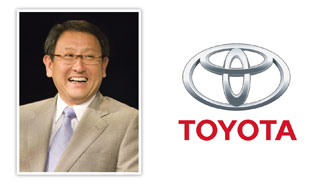Toyota Quality Advisory Panel Proposes Several Changes

Along with reiterating no electronic problems or software errors could have resulted in unintended acceleration in Toyota vehicles, the automaker’s North American Quality Advisory Panel also made a series of recommendations.
In a public report released Monday, Toyota’s independent panel of experts suggests that the OEM loosen its tightly controlled global structure. The panel also recommended Toyota should give more autonomy to its North American operations and have a more open view regarding quality and safety issues raised by external sources.
The panel’s report focuses on three key issues related to Toyota’s quality and safety processes:
—Toyota’s balance between global and local management control.
—Toyota’s responses to problems raised by internal and external sources.
—Management responsibilities for quality and safety at Toyota.
In discussing Toyota’s balance between global and local management control, the panel explained that “In today’s world, major auto manufacturers must strike a balance between the economies of scale associated with centralized control and the need to stay closely connected to customers in diverse local markets.”
The panel stressed, “Toyota was out of balance — it centered too much control in Japan and gave its North American operations inadequate decision-making authority to handle quality and safety problems affecting vehicles in North America. Toyota’s reputation in North America suffered as a result.”
As the report notes, Toyota has already taken several steps to provide North America with more autonomy and decision-making authority.
In connection with Toyota’s responses to problems raised by internal and external sources, the panel believes Toyota had developed a stellar reputation for building high-quality vehicles, in part, because of its extremely effective internal problem-solving processes that roots out and fixes manufacturing defects with great efficiency and speed.
“However, the panel observed that Toyota should apply those principles to its management decision-making processes more comprehensively, especially in response to quality and safety issues raised by external sources like customers and regulators,” report authors indicated.
“Toyota seems to be eager to hear and take action on negative feedback generated from inside sources. However, Toyota sometimes responds less constructively, often with defensiveness, to criticism from outside sources,” they continued.
Meanwhile, when touching on management responsibilities for quality and safety at Toyota, the panel acknowledged that, “We were concerned that Toyota did not have a chief safety officer with overall responsibility for safety company-wide. It only had a chief quality officer.
“We learned that at Toyota, safety is part of its quality process and that everyone has a responsibility for safety,” the panel continued. “However, we fear that this philosophy might suffer from the old adage ‘when everybody is responsible, nobody is accountable.’”
At the panel’s suggestion, Toyota recently named a chief safety technology officer for the entire company.
“Although the job description is still in development, the panel feels this is an important step in the right direction,” members surmised.
Toyota Reacts to Report
Responding to the public release of the panel’s report, Toyota Motor Corp. president Akio Toyoda said, “We appreciate the panel’s efforts to help us further strengthen our processes, and we thank this distinguished group for their recommendations.
“Over the past year, Toyota has learned a great deal from listening to the panel’s valuable counsel,” Toyoda continued. “Their advice has been reflected in the meaningful steps we’ve taken to give our North American operations more autonomy and become an even more safety-focused and responsive company.
“Now, the panel has given us further insights into how we can best achieve our vision of exceeding customer expectations with the safest and most responsible vehicles,” he went on to say.
Also offering his report assessment was Steve St. Angelo, Toyota’s North American chief quality officer.
“We especially appreciate the panel’s candor and how they want us to achieve the highest possible standards for safety and quality,” St. Angelo insisted.
“Right from the outset, we told them we wanted them to be straightforward with us because we seriously want to keep improving our processes and our transparency,” he continued. “It is important to note that the panel focused primarily on how we operate and communicate. While I am glad they’ve recognized the positive changes we’ve already made, I also appreciate how they want us to keep at it. I’ve told them we intend to do just that,” St. Angelo added.
The automaker’s top North American quality officer also shared how the panel scoured facilities directly within his jurisdiction.
“Over the past year, the panel has spent many hours at our various facilities and they have seen many of our 30,000 American team members in action,” St. Angelo shared.
“They have told me personally how much they are impressed with our team and the way we build our vehicles — and I am pleased that our people and our production system were recognized in their report,” he stated. “All of us at Toyota are proud of the vehicles we produce and committed to ensuring that our customers are absolutely confident in their safety and reliability.”
History of Panel
Toyota was under siege in 2009 and 2010 by regulators, lawmakers and the public for its response to incidents of unintended acceleration in Toyota and Lexus vehicles. Amid this crisis, Toyota appointed the seven-member North American Quality Advisory Panel, a diverse group of experts spanning the corporate, government, education and non-profit sectors.
Although the panel was appointed in the middle of Toyota’s unintended acceleration crisis, the automaker emphasized its mission was much broader: conduct a thorough review of the company’s quality and safety processes and make recommendations on ways to improve them.
The report is intended to include the panel’s observations and forward-looking recommendations to improve Toyota’s overall quality and safety processes.
Rodney Slater, panel chairman and former U.S. Secretary of Transportation, remarked that, “It has been said that a good company takes a problem and solves it, but a great company takes a problem and learns from it.
“Toyota has clearly learned some important lessons and will continue to do great things for drivers and for the countries in which it operates,” Slater continued. “Toyota appears to be committed to applying what it has learned to make important changes to improve its quality and safety processes, but there is more to be done. We hope this report helps Toyota in that endeavor.”
Analyst on Panel Report
Edmunds.com chief executive officer Jeremy Anwyl didn’t tread lightly when discussing this panel report.
“The report makes a pretty good case that Toyota let quality lapse. Also, it confirms our view that Toyota’s culture — one that works well in times of stability — left it uniquely vulnerable to a fast-moving crisis, such as the safety issues that enveloped the company last year,” Anwyl surmised.
“But anyone hoping that this report would help settle the debate around causes of unintended acceleration will be disappointed,” he continued.
While the document provides worthwhile recommendations for Toyota going forward, Edmunds.com contends it did not shed new light on the causes of unintended acceleration that occurred in Toyota models.
“As we have noted before, in the absence of a definitive resolution consumers are left to speculate,” stated Anwyl.
He wrote in an op-ed for The Washington Post last year saying that, “it is impossible to rule out any possibilities: electrical, mechanical, design or driver-related.”
Edmunds.com plans to announce at its Safety Conference in Washington, D.C., that there is no winner of the site’s Unintended Acceleration Contest launched early in 2010 after the safety of Toyota vehicles came into question.
“Evidence has been piling up that unintended acceleration is not caused by a vehicle defect, and our contest result seems to be the final piece. Even with a million dollars motivating the best and brightest thinkers to study the issue, no one could demonstrate any novel and plausible cause for unintended acceleration,” Anwyl explained.
“This leaves the blame at the foot of the driver, literally. And this will be a big take-away of Edmunds’ Safety Conference. Culturally, we have an aversion to blaming the driver, but to improve the safety on our roads, we need to recognize the role of the driver and engage the driver more fully,” he went on to say.
Toyota to Launch Private Social Network
In other company news coming out of Tokyo, Salesforce.com and Toyota announced they formed a strategic alliance to build Toyota Friend. This new initiative is described as a private social network for Toyota customers and their vehicles.
Officials explained Toyota Friend will be powered by Salesforce Chatter, a private social network used by businesses, and will be offered first in Japan, initially with Toyota’s electric vehicles and plug-in hybrid vehicles due in 2012.
The automaker hopes Toyota Friend will be a private social network that connects Toyota customers with their cars, their dealership and with Toyota. The company thinks Toyota Friend can provide a variety of product and service information as well as essential maintenance tips, creating a rich ownership experience.
For example, officials shared that if an EV or PHV is running low on battery power, Toyota Friend would notify the driver to re-charge in the form of a “tweet”-like alert.
In addition, while Toyota Friend will be a private social network, customers can choose to extend their communication to family, friends and others through public social networks such as Twitter and Facebook. The service will also be accessible through smart phones, tablet PCs, and other advanced mobile devices.
To date, TMC has developed its own telematics services to connect people, vehicles and their surroundings.
Through Toyota Friend, the OEM aims to offer its telematics services worldwide. Moving forward, the company plans to advance toward the realization of future mobility by teaming up proactively with global IT companies.
Although Toyota and Salesforce.com will launch their partnership with the building of Toyota Friend, in the future the companies plan to develop cloud services for the automaker’s open platform and create new business opportunities leveraging their respective strengths.
Officials highlighted Salesforce.com and Toyota will each make investments in Toyota Media Service Co., which oversees the OEM’s global cloud platform development. Salesforce.com will invest 223 million yen and TMC will invest 442 million yen.
Microsoft Corp., which on April 6 announced a strategic partnership with TMC to build a global platform for next-generation telematics services, will invest 335 million yen.
Regarding the alliance, Salesforce.com chief executive officer Marc Benioff said, “Toyota and Salesforce.com share a vision to take the auto industry into the future. Social and mobile technologies will transform the car ownership experience, and we are excited to be Toyota’s partner in this transformation.”
TMC president Toyoda responded, “Social networking services are transforming human interaction and modes of communication.
“The automobile needs to evolve in step with that transformation,” he added. “I am always calling for Toyota to make ever-better cars. The alliance that we announce today is an important step forward in achieving that goal.”


